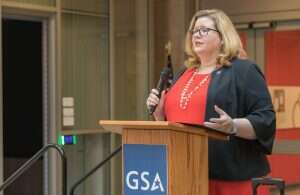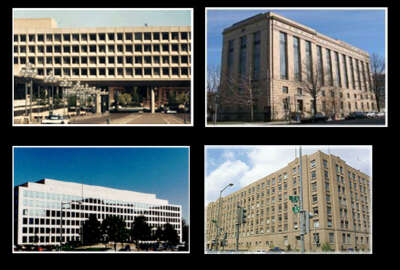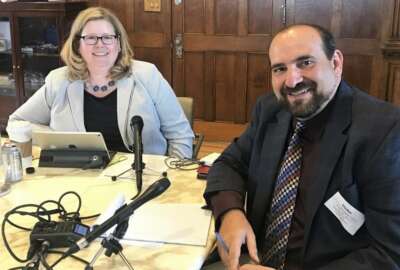

GSA Administrator Emily Murphy said a working group is looking at the acquisition fee structure the agency charges and will develop recommendations to rationalize...
Best listening experience is on Chrome, Firefox or Safari. Subscribe to Federal Drive’s daily audio interviews on Apple Podcasts or PodcastOne.
The General Services Administration is following a simple mantra to guide its agencywide modernization effort—eliminate, optimize and automate.
So far in just the Public Buildings Service alone, the EOA approach has saved almost $2 billion with a goal of saving $5 billion by 2024.
GSA Administrator Emily Murphy said PBS achieved those savings using better, more granular data. Murphy said the service’s experience shows the power and value of information to help GSA modernize and save more money.
“We are trying to take data in, look at problems, analyze those and see if we can do something first to eliminate the problem. Is it a process we need? If so, can we optimize the process, or can we automate it,” Murphy said in an interview with Federal News Network at the 2019 ImagineNation ELC conference.

PBS used the EOA process to save time and money in implementing new provisions in existing leases. It had to do sole source justifications time-and-again for utilities even though there was only one provider. Murphy said GSA worked with the Federal Acquisition Regulations Council to eliminate the rule and therefore ended the need to do a lot of unnecessary paperwork.
Murphy said PBS is also applying robotics process automation (RPA) to do bi-lateral modifications for more than 8,000 leases to add the provision that prohibits the use of ZTE, Huawei and other Chinese made telecommunications and video surveillance equipment.
“That means instead of leased contracting officers filling out forms and sending them out to everyone. We instead now have them press a button to send out the modified lease and then they can sign and ratify when it comes back,” Murphy said. “This is saving time and money.”
When it comes to optimization, PBS analyzed the data to realize that GSA headquarters had space to bring in the employees who worked in the National Capital Region in a separate building.
“At central office, we looked at how often do people scan in, how often do they check out desks and how do they want to use space? We found even on our busiest day, we had over 1,000 vacant desks, which meant we could consolidate folks out of the NCR building, bring them in, restack the building and put them in. We still will save over $10 million a year by bringing them in,” Murphy said. “It then gives us a building that we can then go in, renovate and make it available to another federal agency and get them out of leased space. The savings will cascade.”
Murphy said she has tried to alleviate any concerns about the move of NCR into the central office building by talking to employees and hosting town halls.
“Hopefully, the promise that we will give them nice, clean, modern space in central office [will alleviate any concerns]. We are working on making some improvements to that space so that we can all better utilize it,” she said. “I know there has been some concern that we are trying to absorb them into central office and they will not keep their own character as a region. That’s not the intention. That’s one of the reasons we made sure they will have their own dedicated space within the building and continue to function as a region, but just co-located with us.”
Murphy said the utilization data is giving GSA more reason to talk to other agencies about whether they can move into federally-owned space, which she said is almost always cheaper.
GSA has 368 million square feet in their real estate portfolio and about 50% of that is leased spaced. Of that leased space, 50% of those leases are expiring in any given year.
“About 20% of those leases account for 80% of the savings. Anything we can do to move the needle on those, results in real savings for taxpayers and agencies,” she said.
The real estate data is one of several areas a new integrated and unified dashboard will highlight how GSA is working with any one agency.
“I can go in and look at, for example, the Department of Commerce and see how GSA is interacting with Commerce from a federal acquisitions standpoint, from a real estate standpoint, from a technology standpoint and from a fleet standpoint. We are trying to draw together all the different points of contact,” Murphy said. “Our customers don’t think of us as a PBS or FAS or Technology Transformation Service or a Governmentwide Policy Office. They think of us as GSA. I issued a policy during customer experience week to talk about how we are going to start analyzing data as an agency rather than just thinking about it as PBS data or FAS data or any one particular office’s data.”
The Federal Acquisition Service’s data showed it was bringing in record revenue in fiscal 2018. GSA estimates FAS will earn about $68 billion in sales, which is 23% more than in 2017.
Murphy said, however, the record revenue doesn’t mean there are any immediate plans to reduce the fees GSA charges for the schedule contracts or assisted acquisition services.
“When I said sales going through schedules are up and FAS is in a healthy financial position, I mean that FAS did more than break even. It has been many years since FAS even broke even. They weren’t scheduled to break even until next year. They came in a little bit above break even this year. Our hope is to take that money and invest it in new tools,” she said. “That doesn’t mean we aren’t looking at fee reform. There is a group in FAS that is looking at rationalizing the fees and making sure we have a good understanding of what those fees are going to be. I’ve asked for a proposal on what that will look like. I don’t know that we are ready to go forward with anything at this point and time, but it’s always on my mind as I want to make sure we aren’t charging too much and that I’m leaving FAS in a very healthy standpoint so it can continue.”
Copyright © 2025 Federal News Network. All rights reserved. This website is not intended for users located within the European Economic Area.
Jason Miller is executive editor of Federal News Network and directs news coverage on the people, policy and programs of the federal government.
Follow @jmillerWFED



 Exclusive
Exclusive 